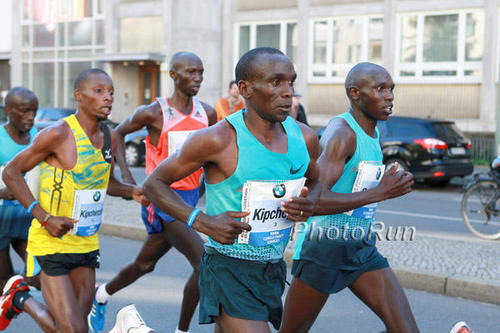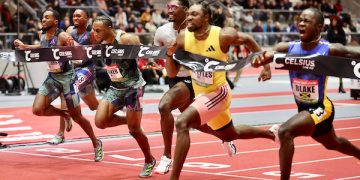Justin Lagat has written about the sport of athletics in Kenya for RunBlogRun for several years now. This is his piece, from February, about his joining one of the elite marathon training gorups, and what that experience is like to do 2000 meter and 1000 meter repeats with the best marathoners in the world.
 Elud KIpchoge, Wilson Kipsang, Berlin 2013, photo by PhotoRun.net
Elud KIpchoge, Wilson Kipsang, Berlin 2013, photo by PhotoRun.net
My experience in trying to keep up with Eliud Kipchoge, Emmanuel Mutai, Stephen Kiprotich, Bernard Kipyego and Geoffrey Kamworor, among others, during their training.
If there is one training session to remember for a very long time in my life, it will be when I trained with some of the world’s best marathon runners earlier this week (February 19) at the University of Eldoret’s track facility. It was one tough workout that affected me to an extent that I became bedridden, not the following day, but on the third day after the tough track workout with them. I called one of the athletes in their camp to seek advice on whether I should go to hospital and he reassured me that everything was just fine with me. That is normally what happens when you try to keep up with the 2:04 guys in their training, he told me. He was right, because I recovered completely the day that followed.
Below is how it all happened.
A few minutes to 7 AM, I was already at the track facility warming up as I awaited the group to arrive. This group normally alight from their minibus a few kilometers from the track and the coaches drive ahead of them as they follow jogging as their warm up. This worked fine for me since I needed to talk to the coach to seek permission before the athletes could arrive. It was not my first time in this group, but I just had to follow the right protocol before joining the group.
As soon as the athletes arrived, we all quickly changed into short tights and lighter T-shirts before doing some 100m dashes around the track, just to test the surface and get ready for the intervals. The workout for the day was five sets of 2000m and 1000m repetitions. The recovery was a 200m jog after every interval.
Since I did not want to interfere with the pattern, I choose to join the line of the over twenty athletes from behind as we went out for the first 2000m interval. It was a long line and by the time I crossed the starting line, the leading athletes were already over 50m ahead.
The first 400m lap was crossed in about 69 seconds, same with the second lap, and I was still hanging there. Then, I noticed that a gap was beginning to open up somewhere about five runners ahead of me, but no one was willing to overtake to close it. It looks like everyone was doing his best to hang wherever they were. I was too. Being a windy day, the going was tougher on the back straight running against the wind as dust raised by about twenty athletes ahead of us made our breathing difficult and entered our eyes. Completing the first 5 lap interval alone was very demanding and it was hard imagining that nine more remained. The leading athletes had opened up about 200m on us as they finished and we had to cut our recovery by jogging faster in order to catch up with them before the next interval.
A 1000m interval would follow each 2000m interval and this was helpful in that we, the athletes from behind, would get a better time to recover after the shorter intervals since the leading athletes would not be able to open such a big gap.
After three 2000m intervals and two 1000m intervals, the best I can use to describe the state I was at that point is “semi-unconscious.” The gap being generated by the leading athletes had begun to grow and I hardly had any time to recover before the next interval. I had reached a point where I did not even know how many more intervals remained nor tell the number of laps remaining in an interval. I was only running and glancing at the opposite side of the track to see if the leading athletes had stopped. Wilson Kipsang’s group and one other different group had also entered the track and were doing their intervals too, making it hard to focus on maintaining the gap with my group.
The leading pack almost lapped me on their last 400m lap during the fourth 2000m interval and I had to do my best to finish one more lap and try to still catch up with them before they could finish the 200m recovery; which ended up being a continuous 600m hard run for me before the figure of the coach blocked my path. I was detached from the group and asked to recover before finishing the remaining 2 intervals in the company of one elite lady in the group who had all along been doing her intervals separately.
I am excited that I will be joining this exciting group of world renowned marathon runners for the next few months and it will be a great privilege to be able to measure my progress and see how far off I am from a 2:04marathon, since a number of runners in this group have run that time.
Author

Since 2013, Justin Lagat has written for RunBlogRun. His weekly column is called A view from Kenya. Justin writes about the world of Kenyan athletics on a weekly basis and during championships, provides us additional insights into the sport.
View all posts




















